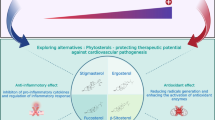Abstract
Three groups of sixteen male rats each were fed semipurified diets containing 15% by weight of lipid for a period of 4 wk. The diets contained the same amount of polyunsaturated fatty acids (PUFA) (20% of total fatty acids) and saturated fatty acids (19% of total fatty acids). Dietary PUFA were represented exclusively by linoleic acid (18∶2 diet), or 10% linoleic acid and 10% linolenic acid (18∶3 diet), or 10% linoleic acid and 10% long-chain n−3 fatty acids (LCn−3 diet). The overall amount of vitamin E was similar in the three diets,i.e, 140, 133 and 129 mg/kg diet, respectively. Following appropriate extraction, tocopherol levels in heart, liver, brain, adipose tissue (AT) and plasma were measured by high-performance liquid chromatography. The level of vitamin E in the heart decreased with n−3 PUFA diets, most markedly with LCn−3 PUFA. Liver and AT vitamin E contents also decreased with n−3 PUFA diets when expressed as μg/mg total lipids and μg/mg phospholipids, respectively. Total plasma vitamin E was lower in rats fed the LCn−3 diet, but there was no significant difference when expressed as μg/mg total lipids. Brain vitamin E was not affected by the various diets.In vitro cardiac lipid peroxidation was quantified by the thiobarbituric acid reactive substances (TBARS) test. Heart homogenates were incubated at 37°C for 15 and 30 min in both the absence (uninduced) or presence (induced) of a free radical generating system (1 mM xanthine, 0.1 IU per mL xanthine oxidase, 0.2 mM/0.4 mM Fe/ethylenediaminetetraacetic acid). TBARS release was time-independent but significantly higher when LCn−3 fatty acids were fed to rats in either the uninduced or induced system. The study demonstrated that n−3 PUFA diets can influence vitamin E status of rats even in short-term experiments and can change the susceptibility of the heart toin vitro lipid peroxidation.
Similar content being viewed by others
Abbreviations
- AT:
-
adipose tissue
- DHA:
-
docosahexaenoic acid
- EDTA:
-
ethylenediaminetetraacetic acid
- EPA:
-
eicosapentaenoic acid
- FA:
-
fatty acids
- HPLC:
-
high-performance liquid chromatography
- LC:
-
long-chain
- NPL:
-
nonphosphorus lipids
- PL:
-
phospholipids
- PUFA:
-
polyunsaturated fatty acids
- TBARS:
-
thiobarbituric acid reactive substances
- TL:
-
total lipids
- X:
-
xanthine
- XO:
-
xanthine oxidase
References
Kromhout, D., Bosschieter, E.B., and De Lezenne Coulander, C. (1985)N. Engl. J. Med. 312, 1205–1209.
Herold, P.M., and Kinsella, J.E. (1986)Am. J. Clin. Nutr. 43, 566–598.
Javouhey, A., Rocquelin, G., Rochette, L., and Juanéda, P. (1990)Nutr. Res. 10, 291–301.
Hammer, C.T., and Wills, E.D. (1978)Biochem. J. 174, 585–593.
Hu, M.-L., Frankel, E.N., Leibovitz, B.E., and Tappel, A.L. (1989)J. Nutr. 119, 1574–1582.
Leibovitz, B.E., Hu, M.-L., and Tappel, A.L. (1990)Lipids 25, 125–129.
Burton, G.W., and Traber, M.G. (1990)Annu. Rev. Nutr. 10, 357–382.
Chautan, M., Calaf, R., Léonardi, J., Charbonnier, M., Andre, M., Portugal, H., Pauli, A.-M., Lafont, H., and Nalbone, G. (1990)J. Lipid Res. 31, 2201–2208.
Rocquelin, G., Yoyo, N., and Ducruet, J.M. (1986)Reprod. Nutr. Develop. 26, 97–112.
American Institute of Nutrition (1977)J. Nutr. 107, 1340–1348.
Potier de Courcy, G., Durand, G., Abraham, J., and Gueguen, L., (1989)Sci. Aliments 9, 209–217.
Burton, G.W., Webb, A., and Ingold, K.U. (1985)Lipids 20, 29–39.
Butriss, J.L., and Diplock, A.T. (1984)Meth. Enzymol. 105, 131–138.
Gallo-Torres, H.E. (1980) inVitamin E: A Comprehensive Treatise, (Machlin, L.J., ed.), pp. 193–267, Marcel Dekker, New York.
Folch, J., Lees, M., and Sloane-Stanley, G.H. (1957)J. Biol. Chem. 226, 497–509.
Juanéda, P., and Rocquelin, G. (1985)Lipids 20, 40–41.
Maupoil, V., and Rochette, L. (1988)Cardiovasc. Drug: Therapy 2, 615–621.
Zaspel, B.J., and Csallany, A.S. (1983)Anal. Biochem. 130, 146–150.
Pyke, D.D., and Chan, A.C. (1990)Arch. Biochem. Biophys. 277, 429–433.
Meydani, S.N., Shapiro, A.C., Meydani, M., Macauley, J.B., and Blumberg, J.B. (1987)Lipids 22, 345–350.
McCay, P.B., and King, M.M. (1980) inVitamin E: A Comprehensive Treatise, (Machlin, L.J., ed.), pp. 289–317, Marcel Dekker, New York.
Drevon, C.A. (1991)Free Rad. Res. Commun. 14, 229–246.
Bourre, J.-M., Durand, G., Pascal, G., and Youyou, A. (1989)J. Nutr. 119, 15–22.
Author information
Authors and Affiliations
About this article
Cite this article
Javouhey-Donzel, A., Guenot, L., Maupoil, V. et al. Rat vitamin E status and heart lipid peroxidation: Effect of dietary α-Linolenic acid and marine n−3 fatty acids. Lipids 28, 651–655 (1993). https://doi.org/10.1007/BF02536061
Received:
Revised:
Accepted:
Issue Date:
DOI: https://doi.org/10.1007/BF02536061




